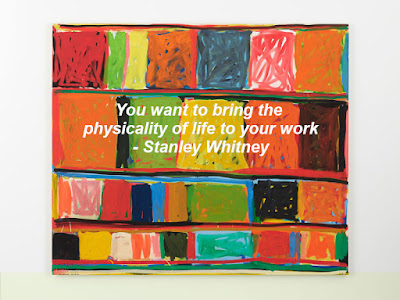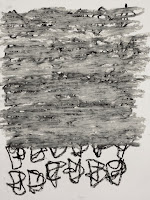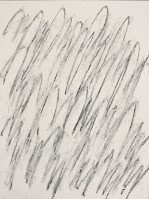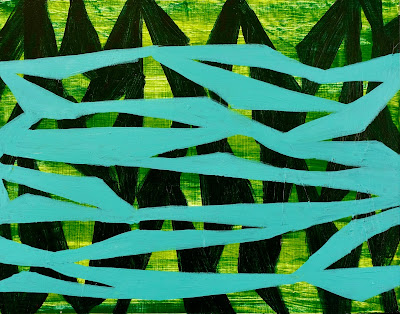Monday, March 08, 2021
Solutions: don't take the obvious for granted
Sunday, March 07, 2021
The physicality of life in art
Saturday, February 20, 2021
Nine drawings
Friday, February 12, 2021
Art Doesn't Make the Artist
“I can't always relate to your work, but I can always relate to you, and that is what mattered.”
This quote is from someone who is a former coworker of mine that I still stay in touch with. We both worked for a long time at a food retail job in Philadelphia as managers. The business switched hands a couple of times after the original owner retired. I didn't last past the second changeover, but Kerry P. did, although he eventually left there, as well. Kerry is someone who will say what is on his mind and is pretty open with people. It's one of the things I like about him.
The above quote is from an email exchange we had not long ago. What he said here has really stuck with me because of its honesty. What I make as an artist isn't going to appeal to everyone and there's nothing new about that, it's a simple truth of life, in general. I don't really worry about who will like/dislike my work. I'm more concerned with making it and having it out in the world to be experienced. I guess what it brings up for me is the importance of interpersonal relationships and how we navigate them as artists. What I'm trying to get at is that, deep down, we want a response to our work. If that happens, good or bad, then I think most of us will be satisfied. How we handle those reactions is also key. I wasn't surprised by Kerry's pronouncement of not being able to relate to what I do, since he has said in the past that he has a limited understanding of contemporary art.
This part, "...but I can always relate to you, and that is what mattered.", is key. It brought home the thought that what we do isn't all that we are. Art has always been a MAJOR part of my life, but just one part, not all of it. I live, breath and eat art, but it isn't the only thing that makes up who I am as a person. I've always felt this way. Often, I think that people can tend to subsume their entire personalities and motivations into what they see as the one thing that makes them who they are. While I believe there is no separation between art and life, art isn't all of life. There are so many other factors that go into what makes up who we are. Much of that has to do with perceptions of us from others. Our personalities and beliefs are made up of our own experiences, how other people experience/perceive us, as well as our own perceptions of the world and others.
I think I could have easily taken offense to Kerry's remark, saying something like, "What do you mean, you can't relate to my art but you can relate to me? Isn't my art part of me?" and so on. However, that wasn't the case. I accepted his comment because that's his truth, plain and simple. He relates to me as a person from a certain part of his life (work, mostly) and he's had difficulty relating to some of my artwork. It doesn't negate my whole being as a person, if anything, it can open up a path for further discussion about my work and his relationship to it. It's easy to conflate our main occupation with the entirety of our self worth, but in the end, there's way more to us than what we think we know through our work.
TM
Shockoe Artspeak and the enduring myth of the "starving artist"
Saturday, February 06, 2021
Commitment: Fuel for the Marathon
Thursday, January 14, 2021
Black and Abstract
Last year, during the social upheaval and protests after the extra-judicial killings of George Floyd, Breonna Taylor and countless other Black and Brown people by police, I questioned whether my work could be relevant for the moment. Being a Black artist working with abstraction, I felt like what I do wouldn’t mean much to people, and other Black people, in particular. Art made by Black artists has almost always been expected to reflect the Black community; its struggles against white supremacy, strength in community and various aspects of Black life. Realism being the preferred avenue of messaging. In this context, abstraction by Black artists, until relatively recently, has been, at times, disdained by Blacks and willfully ignored by the greater art world. This is the lens through which I understood things as a young artist in my late teens and early twenties, even though it took me a bit longer to fully understand and fully embrace my own need and reasons to make non-objective art.
My last years of high school on through to my sophomore year of college saw a big shift in the type of work that I wanted to pursue as an artist. I had learned and practiced the basics of color, drawing, line, form, composition, etc… through realism. Going into my last couple of years in college, I had begun to discover that realism had limitations for me that I couldn’t ignore. By this time, in the late 1980s, I’d begun paying more attention to contemporary art through regular trips to galleries and museums in Philadelphia and New York. A whole other world opened up for me. At the same time, I was finding out more about how Black artists were highly underrepresented in the wider mainstream art world and when they were accepted, there seemed to be a very narrow view of the type of artwork made by Black artists that was acceptable. Basically, almost anything that centered around Black figuration and themes of struggle and community were “acceptable”, a trope that seemed to be the consensus of the Black community and the white-dominated mainstream art world. This is how I understood it at the time. There were very few Black artists, male or female, that were being recognized with shows in New York and other big art cities around the U.S. The biggest exception that I knew of at the time, was Jean-Michel Basquiat. It wasn’t until much later that I would become aware of Black abstract artists like Sam Gilliam, Howardena Pindell, Norman Lewis and Ed Clark, to name a few.
Around the late 80s to early 90s, I took an interest in the work of American Abstract Expressionists and later abstract artists, which provided the aesthetic kick that I needed to move into the beginnings of discovering and molding my own non-objective voice. Just prior to this, I had begun to lean into a kind of rejection that would fuel my practice for a long time. The rejection I focused on was what I perceived at the pigeon-holing of Black artists and art by both Black and white establishments. Both Black communities and the mainstream art establishment only seemed to champion a type of social realism that felt overused and limited in its scope, in my view. An only child, I had developed an independent streak pretty early on, so it’s no surprise to me that I took the route that I did in my work. Later, after high school, one of the things that spurred me on as a young artist, was wanting to prove, mainly to myself, that I could make non-objective work that was just as good as any of the white abstract artists that I had knowledge of at the time.
Flash forward to now and with almost 40 years of art making behind me, I still have moments of wondering if what I’m doing matters in certain ways. The truth is, what I do as a Black artist working with abstraction isn’t going to resonate with everyone and it definitely isn’t going to directly solve any of the social ills that continue to plague the Black community or other communities. What it can do is provide another way of seeing, another way of helping people to see, to question their world and themselves, perhaps. Also, to show a way forward, to be a testament to hope and a future. The one certainty about making art is that it is an act of faith. It’s an act of faith that assumes a future simply because of its existence. The will to make a painting, sculpture, film or other creative endeavor means that there is some amount of faith in the maker that a future is possible.
The events of 2020, now bleeding into 2021 are way beyond the scale of what my painting can do. However, the smaller scale individual value that I and my work bring to the table is that of questioning, standing in one’s own truth, through confidence and perseverance. I don’t know what people look for or see in my work. My only hope is that it can provoke a feeling of some kind, good or bad. That is communication, that is making a connection. Whatever connections viewers make with the work is out of my hands, on the other hand, having had the faith to make the work and put it out into the world for people to witness and experience is all I need. I have other goals, like having my work represented in major art institutions and collections worldwide. However, those ambitions have been a secondary concern for me. At this point, I have good gallery representation, my work is included in many private and university collections and I continue to have work shown, something that I didn't imagine would happen as a teenager, so I now know that it's possible and I welcome bigger things. However, continuing to paint and make the non-objective work that I want, being in dialogue with other artists across time, regardless of who may or may not see it, like it or not, or whatever else is going on in the world is the ultimate success for me.














